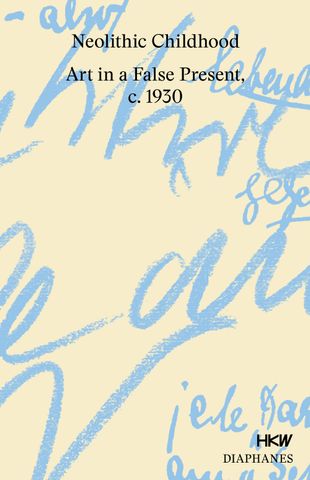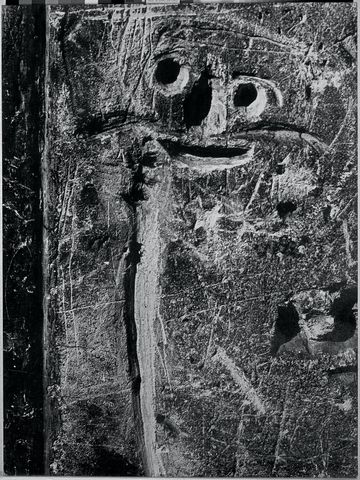Neolithic Childhood. Art in a False Present, ca. 1930

Edited by Anselm Franke and Tom Holert
Haus der Kulturen der Welt / Diaphanes, 2018
460 pages, English
296 illustrations, of which 128 in color, bound
ISBN 978-3-0358-0106-4
Price: 50 €
Available at Haus der Kulturen der Welt and at bookstores, mail order buying / postal shopping via the webshop
Resonating at the heart of Neolithic Childhood. Art in a False Present, c. 1930 is the question whether art has present, past, and future functions. The modernist assertion of the autonomy of art was intended to render superfluous art’s social and religious functions. But what if the functionlessness of art comes under suspicion of being instrumentalized by bourgeois capitalism? This was an accusation that informed the anti-modernist critique of the avant-garde, and particularly of Surrealism. The objective throughout the crisis-ridden present of the 1920s to the 1940s was to reaffirm a once ubiquitous, but long-lost functionality—not only of art.
The publication accompanying the exhibition examines the strategies deployed in this reaffirmation. These include the surrealist Primitivism of an “Ethnology of the White Man” together with the excavation of the deep time of humanity—into the “Neolithic Childhood” mapped out by the notoriously anti-modernist Carl Einstein (1885-1940) as a hallucinatory retro-utopia. The volume brings together essays by the curators and academics involved in the project, primary texts by Carl Einstein and a comprehensive documentation of the exhibition including lists of works, texts on as well as images of numerous exhibits and finally installation views. At the center of the volume, a glossary discusses Carl Einstein’s own theoretical vocabulary as well as further associated terms, such as Autonomy, Formalism, Function, Gesture, Hallucination, Art, Metamorphosis, Primitivisms, Totality.
With contributions by: Irene Albers, Philipp Albers, Joyce S. Cheng, Rosa Eidelpes, Carl Einstein, Anselm Franke, Charles W. Haxthausen, Tom Holert, Sven Lütticken, Ulrike Müller, Jenny Nachtigall, David Quigley, Cornelius Reiber, Erhard Schüttpelz, Kerstin Stakemeier, Maria Stavrinaki, Elena Vogman, Zairong Xiang, Sebastian Zeidler
With reproductions of artworks by:
Jean (Hans) Arp, Willi Baumeister, Georges Braque, Brassaï, Claude Cahun, Lux T. Feininger, Max Ernst, Florence Henri, Barbara Hepworth, Hannah Höch, Heinrich Hoerle, Paul Klee, Germaine Krull, Helen Levitt, André Masson, Alexandra Povòrina, Gaston-Louis Roux, Kalifala Sidibé, Louis Soutter, Yves Tanguy, Toyen, Jindřich Štyrský, Raoul Ubac, Paule Vézelay und anderen.
Table of contents:
Foreword
Bernd Scherer
Introduction
Anselm Franke, Tom Holert
Editorial note
Handbook of Art
Carl Einstein
Essays
The Speckled Leopard of the Mixed Self: Chaos Theory, c. 1930
Tom Holert
Vitalism/“Living” Form
Jenny Nachtigall
After Cosmogony: Carl Einstein on Jean Arp
Sebastian Zeidler
Neolithic Childhood
Carl Einstein
Why Did the 1930s Identify with Prehistory?
Maria Stavrinaki
Russian and Non-Russian Proletkult
Kerstin Stakemeier
Flipping the Bird: Toyen
Ulrike Müller
Global Art 1929: Kalifala Sidibé
Irene Albers
Glossary
Formalism
Jenny Nachtigall
Function
Tom Holert
Handbuch der Kunst
Charles W. Haxthausen
Autonomy I
Sven Lütticken
Knowledge
Tom Holert
Mimesis, Redoubled
Rosa Eidelpes
Myth[ology]
Sven Lütticken
Totality
Jenny Nachtigall
Art
Tom Holert
Blackbirds
Irene Albers
Avant-Garde
Chiara Marchini
Autonomy II
Kerstin Stakemeier
Primitivisms
Joyce S. Cheng
The Training of Ecstasy
Irene Albers
Gesture
Elena Vogman
Metamorphosis
Joyce S. Cheng
Nomadic/Sedentary
David Quigley
Hallucination
Tom Holert
Entdinglichung
David Quigley
Pornophilia
Kerstin Stakemeier
Transdualism
Zairong Xiang
Boomerang Effect
Erhard Schüttpelz
The Anti-Colonialism of the Surrealists
Irene Albers
Ethnologie du blanc
Irene Albers
Archival Materials
Section A
The Impossible Expansion of History
The Crisis (of Everything)
Picture Atlas Projects of the 1920s (Propyläen Kunstgeschichte, Orbis Pictus,
Kulturen der Erde, Das Bild, and Handbuch der Kunstwissenschaft)
Art Historical Images of History and World Art Stories
From Ethnological Art History to the New Ethnographic Museums
Models of Temporality
Functions of the “Primitive”
The Art of the “Primitives”
The Precise Conditionality of Art
Carl Einstein, “Handbuch der Kunst”
“The Ethnological Study of Art”: African Sculpture
Archaeology as a Media Event
Prehistory in the Abyss of Time
The Prehistory of Art: Rock Drawings and Cave Painting
The Paleolithic/Neolithic Age: Mankind’s Childhood?
Fundamental Crisis: Ontological Revolution and Formalization
Section B
The S/O Function
The Present and Contemporary Art
Children’s Drawings and
Questions of Origins
The S/O Function
Pornophilia
Occultism
Automatism, Dream, Hallucination, Hypnosis
Image-Space of Biology
Artistic Research: Ethnology, Archaeology, Physics
Gesture—“a flash in slow motion through centuries of evolution”: Sergei Eisenstein’s Method
The Expedition as a Medium of the Avant-Garde (Dakar–Djibouti and Subsequent Missions)
Ethnology of the White Man?
Theories of Fascism in France
Fascist Anti-Primitivism. “Degenerate ‘Art,’” 1937
Braque/Einstein: World Condensation
The Two Lives of Myth
Ur-Communism, Expenditure, Proletarianization
Section C
Resistance and Lines of Flight
The “Exposition coloniale internationale” and the Anti-Colonialist Impulse
Afro-Modernism and “Self-Defense”
Kalifala Sidibé:
Colonial or Global Artist?
The Port: Contact Zone and Space of Mobilizations
Conversion into the Fight: The Spanish Civil War
Installation Views
